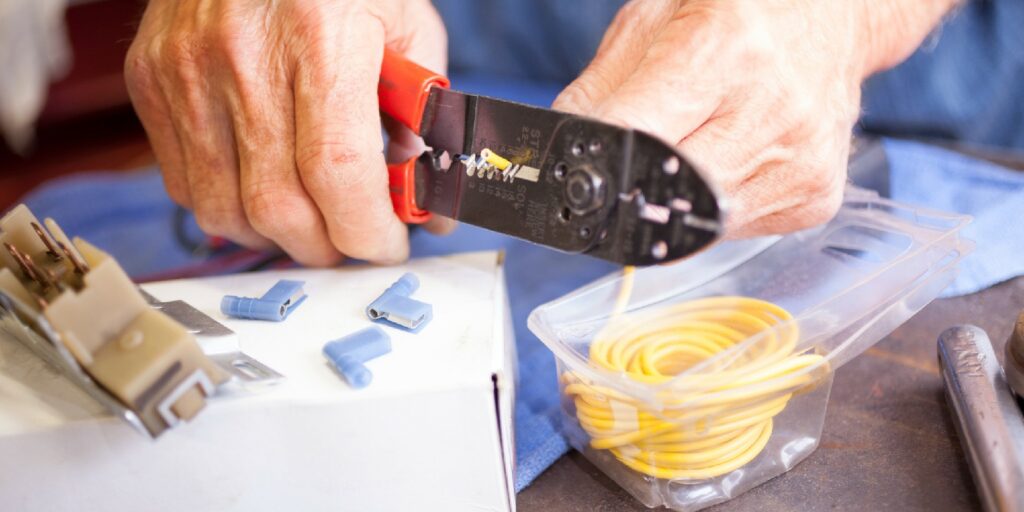A Complete Guide on How to Crimp Wires Safely

Crimping wires is an essential skill that everyone should learn. Doing so safely is key in preventing surprises that could cause harm or damage. In this article, we’ll take you through a complete guide on how to crimp wires safely. We’ll cover the equipment you’ll need, the safety precautions you should take, and the steps you should follow when it comes to crimping the wires.
So, if you’re looking to crimp your own wires and don’t know where to start, this guide is for you. We’ll make sure to provide you with the best tips and advice on crimping wires safely, so you can get the job done with confidence.
Understanding the Basics of Crimping
Crimping is a simple process. It requires joining two or more pieces of metal together by compressing them using a special tool called a crimper. This tool applies pressure that deforms one or more components to make a connection. Crimps may also be used on non-metallic materials such as plastic or rubber, usually to join pieces together in an assembly or to attach a connector to the end of a cable. The goal of crimping is to provide a strong gripping force on the component that is being attached so the joint will not come loose over time due to vibrations or other forces acting on it.
Preparing the Wires for Crimping
Before beginning any crimping process, it is important to prepare the wires for crimping. This includes removing any insulation from around the wires (if applicable) and stripping the ends of the wires so that they are exposed and ready for connecting. It is also important to make sure that all edges of the wires are smooth before beginning to crimp.
Choosing the Right Type of Crimp
The type of crimp used depends on the type of material being used (e.g., aluminum, copper, etc.) as well as the required strength and conductivity of the connection. Different types of electrical connections require different types of crimps, such as butt splices or open barrel contacts. It is important to identify which type of crimp is necessary for each application in order to ensure proper connections and a secure fit.
Applying the Crimp
Before applying any pressure with the crimper, it is important to ensure that all components are properly aligned and positioned correctly in order to get an even crimp and avoid any damage or injury that could occur from an improperly applied crimp. Once everything is aligned, the next step is to squeeze the handle on the crimper tool until it securely locks into place, then pull back until you feel resistance (or release when done). This will provide enough pressure on both components so that they are held securely together for conductivity purposes.
Common Crimping Mistakes
One of the most common mistakes made during the crimping process is not using enough pressure when squeezing the handles on the tool, resulting in an unevenly distributed force across all components and leading to poor conductivity between them. It is also important to make sure that all components are properly aligned before applying pressure with a crimper; otherwise, it could result in damaged parts or injury from an unexpected release of energy due to misalignment. Finally, improper insulation can lead to short-circuiting if not applied correctly after crimping has been completed.
Advantages of Using Tools Developed for Crimping
Using tools specifically designed for crimping offers many advantages over traditional methods such as pliers or solder guns. One major advantage is improved accuracy and efficiency due to pre-set dies within a wire crimping tool which allows for uniform results every time regardless of operator skill level or experience with this type of work—something that cannot be achieved with traditional techniques like pliers or solder guns. Additionally, these tools provide superior gripping force compared with other methods, which helps ensure consistent electrical performance through numerous uses without fatigue or failure over time due to vibration or flexing at joints. These are essential for any long-term applications involving wire or cable connections.
Maintenance of Crimping Tools
It is important to follow recommended maintenance procedures for any wire crimping tool in order to keep them working at their best—especially if they are being used regularly in an industrial setting where safety is critical. This includes using cleaning solvents periodically throughout the lifespan of a tool (especially after prolonged use) as well as lubricating any moving parts with high-quality lubricants like WD40, which can help prolong its efficiency and lifespan significantly over time.
Conclusion
Crimping wires safely is essential to any electrical or industrial work. With the right equipment, safety precautions, and an understanding of the basics, anyone can master the art of crimping. Following the steps outlined in this guide can increase the safety and reliability of your project. The key takeaways to remember are to always have the right equipment, make sure the wires are properly prepared, choose the appropriate type of crimp, apply the proper pressure when crimping, and follow recommended maintenance procedures. This guide provides all the information you need to ensure a successful and safe crimping experience. With the tips provided in this article, you’ll be well on your way to confidently and tightly crimping wires.
